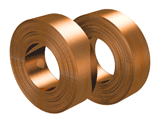Copper
 Copper is a chemical element (Cu). It has been used for thousands of years for many different applications. Today beside its basically use for electrical wires, it plays an important role as roofing, cladding and plumbing products (20%). Its durable and weatherproof nature makes it an excellent product for sustainable roofing and additional for rainwater pipes and gutter. Copper and its various alloys such as brass and bronce are widley used in residential and commercial buildings. The primarily reason for its durability is because of the protective patina that forms on copper surfaces. Another reason is the minimize movements due to thermal changes which is less 40% than zinc and lead.
Copper is a chemical element (Cu). It has been used for thousands of years for many different applications. Today beside its basically use for electrical wires, it plays an important role as roofing, cladding and plumbing products (20%). Its durable and weatherproof nature makes it an excellent product for sustainable roofing and additional for rainwater pipes and gutter. Copper and its various alloys such as brass and bronce are widley used in residential and commercial buildings. The primarily reason for its durability is because of the protective patina that forms on copper surfaces. Another reason is the minimize movements due to thermal changes which is less 40% than zinc and lead.
Copper does not react with water. But it reacts with oxygen and forms a layer of brown-black copper oxide. The mate appearance of copper is the result of tarnishing when exposed to usual atmosphere. Humidity accelerates this process, copper gets darker over time. As a result the changing apearance of copper gives any building an individual touch.
"The green patina that forms naturally on copper and bronze, sometimes called verdigris, usually consists of varying mixtures of copper chlorides, sulfides, sulfates and carbonates, depending upon environmental conditions such as sulfur-containing acid rain. In clean air rural environments, the patina is created by the slow chemical reaction of copper with carbon dioxide and water, producing a basic copper carbonate. In industrial and urban air environments containing sulfurous acid rain from coal-fired power plants or industrial processes, the final patina is primarily composed of sulphide or sulphate compounds." (souce wikipedia)
"Copper corrodes at negligible rates in unpolluted air, water, de-aerated non-oxidizing acids, and when exposed to saline solutions, alkaline solutions, and organic chemicals. Copper roofing in rural atmospheres corrodes at rates of less than 0.4 mm in 200 years." (souce wikipedia)
Economic success and sustainability go hand in hand. Copper is 100% recycable without any loss of quality. Other significant advantages of copper are that it does not require cleaning or maintainance, it is lightweight, very ductile and easily processed.

